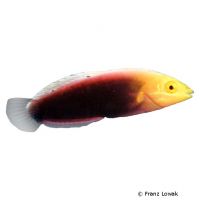Rainbow Wrasse (Halichoeres iridis)
| Rainbow Wrasse Halichoeres iridis | |
|---|---|
| Name | Rainbow Wrasse |
| Name Lat. | Halichoeres iridis |
| Family | Wrasses |
| Family lat. | Labridae |
| Order | Wrasses & Relatives |
| Order lat. | Labriformes |
| Origin | Western Indian Ocean |
| Habitat | Reefs, rubble areas |
| Diet | Carnivore |
| pH | 8,1-8,4 |
| Hardness | 8-10 °KH |
| Behavior | Peaceful |
| Keeping | Individual, pair |
| Reef Compatible | With caution |
| Care Level | Moderate |
| Life Span | 5-7 years |
| Protection | No |
| Metric Units | |
| Size | 12 cm |
| Temperature | 24-27 °C |
| Salinity | 33-36 ‰ |
| Aquarium | ~ 350 l |
| US Units | |
| Size | 4" |
| Temperature | 75-81 °F |
| Salinity | 1.020-1.025 sg |
| Aquarium | ~ 90 gal |
Distribution and habitat
The distribution area of Halichoeres iridis is in the western Indian Ocean and reaches from the East African coast and Madagascar over the Seychelles and the Chagos Archipelago to the Maldives. They live there on steep outer reefs with coral rubble and sand in 5-40 m depth.
Maintenance
They need a well-structured aquarium with plenty of swimming space and a reef structure (hiding, resting and retreat possibilities) with living stones that act like a biological filter as well as sandy areas (no coral rubble!) for burrowing. Only lime-rich, heavy metal-free substrates may be used as substrate.
Filters, skimmers and heaters are necessary to ensure water quality, as well as pumps to simulate tides, swells and bottom currents. Lighting must match the species-appropriate day-night rhythm of the animals
| Salinity: 33-36 ‰ | pH value: 8.1-8.4 |
| Carbonate hardness: 8-10 °KH | Nitrate content: 2-8 mg/l |
| phosphate content: 0.01-0.1 mg/l | nitrite content: 0.0-0.05 mg/l |
For salinity, an average value should be aimed for, which may only vary slightly by +/- 0.5 ‰. Ammonia and ammonium must not be measurable. Special attention must be paid to constantly good water quality.
Diet
In nature, they feed on microorganisms living in the sand. The change of feed usually succeeds without problems. The food supply should consist of a commercially available, vitamin-enriched, frozen food mix or a combination of chopped shrimp and crab meat with live and frozen food, such as mysis, krill, bosmids and Artemia. High quality flake and granulated foods are also well accepted after an acclimation period.
It is recommended to feed small portions several times a day. This also reduces intra-species aggression and protects lower animals in the aquarium
Regular and varied feeding promotes health and increases resistance.
Behaviour and compatibility
The young fish, mostly females, are peaceful among themselves and can be kept without problems. With the sex change to male the aggression increases. Therefore, only one male should be kept alone or a pair. Towards other fish they behave peacefully.
Sex dimorphism
They are protogynous hermaphrodites, i.e. most males develop from functional females and are called "secondary males". They are more colorful than "primary males" (born as males). Adults are more intensely colored than juveniles, males have a greenish band on the back, in females this is red.
Reproduction and breeding
There are no known reports of successful breeding in the aquarium.
Important
They are active swimmers, but will bury themselves in the sandy substrate overnight and when threatened.
It is recommended to keep these typical reef inhabitants together with corals and not to keep them in a fish-only aquarium
Care should be taken when keeping them together with tubeworms, snails and crabs, as these may be considered food
If different species are kept together, care should be taken to match the fish in terms of water quality and temperature requirements and social behavior, and to ensure that the setup meets the needs of all species kept together. New fish to be introduced must be acclimated slowly to the water in the aquarium
Further literature can be found in your pet store.
References
Text: Werner Winter; Image: Franz Lowak
Source: KUITER, DEBELIUS (2007): Atlas der Meeresfische: Die Fische an den Küsten der Weltmeere, Kosmos Verlag; ENGELMANN (2005): Zootierhaltung - Tiere in menschlicher Obhut: Fische, Verlag Harri Deutsch
- Gemäß § 21 Abs. 5 Tierschutzgesetz idgF
